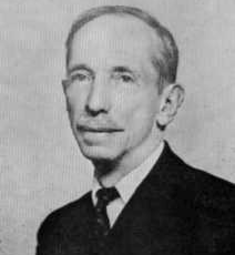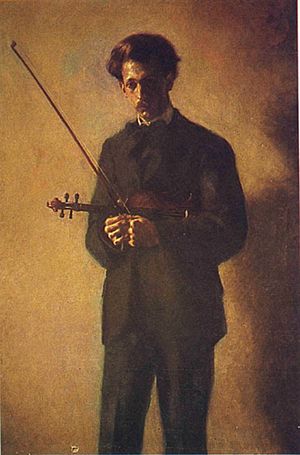Guillermo Uribe Holguín facts for kids
Guillermo Uribe Holguín (born March 17, 1880 – died June 26, 1971) was a famous Colombian composer and violinist. He was one of the most important cultural figures of his time in Colombia. He wrote a lot of music in many different styles. He also started the National Symphony Orchestra of Colombia.
Contents
His Life Story
Guillermo Uribe Holguín was born in Bogotá, Colombia. His father was Guillermo Uribe and his mother was Mercédes Holguín.
While studying engineering, he also learned music. He studied violin with Ricardo Figueroa. He learned how to compose music with Santos Cifuentes and Augusto Azzali. He later found a private teacher named Narciso Garay.
In 1903, he visited New York City. For the first time, he heard professional orchestras and operas. This trip inspired him to start writing 300 short pieces called trozos. These pieces were based on folk melodies and written for different instruments.
In 1905, he became a professor of violin and harmony. That same year, he conducted his piece Victimae Paschali. It was for a solo singer, a choir, and an orchestra.
Studying in Europe
Guillermo received a special scholarship from the Colombian government. This allowed him to study music in Paris, France. In 1907, he studied violin with Armand Parent. He also learned composition from Vincent d'Indy. Other famous students there included Erik Satie and Joaquín Turina.
Later, he took more violin lessons in Brussels. In 1909, his first Violin Sonata was performed in Paris. Because of his time in Paris, his music before 1930 showed a strong French influence. In Paris, he met a pianist named Lucía Gutiérrez. They got married in 1910. Lucía often played the solo parts in his musical works. Sadly, she passed away in 1925.
Returning to Colombia
In 1910, Guillermo Uribe Holguín came back to Colombia. He became the Director of the National Conservatory of Music in Bogotá. In 1932, the French government honored him. They made him a Chevalier of the Légion d'honneur, a very important award.
He left the Conservatory in 1935 to focus on writing music. In 1939, he received another award, the "Medalla Cívica del General Santander." He wrote his autobiography in 1941. He returned as director of the Conservatory in 1942 and stayed until 1947. His last piece of music was Doce canciones, written in 1962. He died in Bogotá in 1971.
His Music Today
Since 2005, a Colombian guitarist named Nilko Andreas Guarin has been helping to bring Uribe Holguín's music back to life. Guarin has been editing and sharing Uribe's works around the world. He performed the first New York show of Pequena Suite, Op. 80, No. 1. This piece was written for the famous guitarist Andrés Segovia, but Segovia never played it. Guarin is also recording some of Uribe Holguín's music that has never been heard before.
One of Uribe Holguín's students was Josefina Acosta de Barón.
His Musical Works
Guillermo Uribe Holguín wrote many different kinds of music.
Operas and Ballets
- Furatena, Op. 76 (1940) - This was a music-drama.
- Tres ballets criollos, Op. 78 - These were three ballets.
Music for Voices and Choirs
- Victimae Paschali - For a solo voice, choir, and orchestra.
- Requiem, Op. 17 - For solo singers, choir, and orchestra. He wrote this to remember his wife.
- Marcha Triunfal, Op. 18 - For a tenor singer and orchestra.
- Himno, Op. 42 - For a tenor, choir, and orchestra.
- Improperia, Op. 65 - For a baritone singer and orchestra.
- Mass - For a children's choir (singing without instruments) and solo voices.
Orchestra Music
- 13 symphonies - A symphony is a long piece for an orchestra. One of them is called Sinfonía del terruño, Op. 15.
- Bochica, Op. 73 - A symphonic poem, which tells a story through music.
- Tres Danzas (Three Dances)
- Serenata
- Carnavalesca
- Marche funebre (Funeral March)
- Marche de fête (Celebration March)
- Suite típica
- Ceremonia Indígena (Indigenous Ceremony)
Concertos
A concerto is a piece for a solo instrument and an orchestra.
- 2 Violin Concertos (Opp. 64 and 79)
- Concerto for viola and orchestra, Op. 109 (1962)
- Concierto a la Manera Antigua - For piano and orchestra.
- Villanesca - For piano and orchestra.
Chamber Music
Chamber music is for a small group of instruments.
- 10 String Quartets - For four string instruments.
- 2 Piano Trios - For piano and two other instruments.
- Piano Quartet - For piano and three other instruments.
- 2 Piano Quintets (Opp. 31 and 66) - For piano and four other instruments.
- 7 violin sonatas - For violin and piano.
- Sonata for viola and piano, Op. 24 (1924)
- 2 cello sonatas - For cello and piano.
- Divertimento for flute, harp, horn and string quartet, Op. 89
- Pequeña suite (Little Suite) for violin, viola and flute, Op. 96 (1955)
Piano Music
- 300 Trozos en el sentimiento popular - These pieces were based on folk dances.
- Many other pieces for piano.
Guitar Music
- Tres Bosquejos
- Suite in Three Movements Pequeña Suite, Op. 80 no 1 (1946) - This piece was written for the famous guitarist Andrés Segovia. Colombian Classical Guitarist Nilko Andreas Guarin edited and performed it for the first time in the US in New York City in 2005.
Songs
- He wrote many songs using words by famous writers like Victor Hugo and Paul Verlaine.
See also
 In Spanish: Guillermo Uribe Holguín para niños
In Spanish: Guillermo Uribe Holguín para niños



